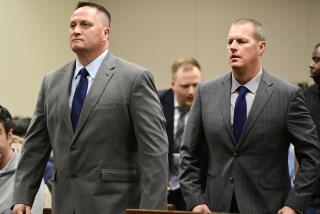Gathers’ Collapse Is Issue : Jurisprudence: Events immediately after the Loyola basketball player fell on the court will be at issue during trial.
- Share via
Nearly 2 1/2 years after the death of Loyola Marymount basketball star Hank Gathers, the unsettled issues in the lawsuit filed by the family finally are about to come to trial.
Jury selection will begin Monday in Los Angeles County Superior Court in Torrance. The case will focus on the events in the minutes after Gathers collapsed during a postseason game at Gersten Pavilion on March 4, 1990.
Gathers, who at the time was being treated for a rapid heartbeat, was pronounced dead at Daniel Freeman Marina Hospital less than two hours after he collapsed. An autopsy listed the cause of death as unknown cardiomyopathy, a heart disorder.
But the Gathers family members who were at the game allege that the negligent actions or lack of actions by the doctors who treated Gathers courtside led to his death and caused them undue emotional distress. The two doctors who treated Gathers before the paramedics arrived deny negligence, as does the employer of one of the doctors.
Two causes of action--negligent and intentional infliction of emotional distress--and three defendants are all that remain of a multi-million-dollar suit originally filed against 14 defendants by Gathers’ mother, Lucille, brothers Derrick and Charles, and an aunt, Carole Livingston Gilmore. The rest of the case was settled four months ago.
But as with almost everything surrounding this case, the trial promises to be anything but simple.
The original suit could virtually be broken into two parts and two time periods. The first portion involved wrongful death claims filed by Lucille Gathers dealing with the moral responsibility of Loyola officials and the treatment Gathers received by doctors before his death. From the settlement, Lucille Gathers received $895,000 and Aaron Crump, Gathers 8-year old son, received $1.505 million.
The second part of the suit deals with the alleged emotional distress suffered by the family members at the game in the moments after Gathers’ collapse. But as Judge J. Gary Hastings, who will preside over the trial, ruled last week, several questions surrounding this issue might make it difficult to preclude evidence or testimony regarding events that occurred before March 4.
The remaining defendants are Dr. Benjamin Shaffer, who was the doctor on duty for the game that night, his employer, Kerlan-Jobe Orthopaedic Group of Inglewood, and Dr. Dan Hyslop, who is an independent contractor for Loyola and works in its student health center. Shaffer and Hyslop treated Gathers when he collapsed. Kerlan-Jobe provided the doctor on duty for Loyola’s home games.
The issues center on Shaffer’s decision to move Gathers outside the gym before the school’s defibrillator was used. The defibrillator, a device used to shock the heart back to a normal rhythm, was purchased after Gathers collapsed a first time while playing Dec. 9. However, Bruce Fagel, attorney for the Gathers family, contends that neither Hyslop nor Shaffer knew how to operate the machine, which delayed in Gathers being defibrillated. He also claims that Hyslop and Kerlan-Jobe had a duty to be trained in its use and to have an emergency plan.
“What happened at the game and the medical issues preceding it is important to this case,” Fagel said. “Hank Gathers was known to have a medical condition that raised the statistical possibility of him collapsing. It was that reason that the defibrillator was purchased.”
Fagel will try to prove two causes of infliction of emotional distress, negligent and intentional. Only Shaffer is named in the intentional cause, and that is the only cause of action in which Gathers’ aunt, Carole Livingston Gilmore, is a plaintiff.
“Intentional infliction is based on outrageous conduct rather than negligence,” Fagel said. “Ben Shaffer’s decision to move Hank rather than treat him, if the jury believes us, is outrageous. It is not an act of omission, but of commission. His first affirmative act was to tell (Loyola trainer) Chip Schaefer to get the stretcher rather than the defibrillator.”
But Richard Carroll, co-counsel with Marshall Silberberg for Kerlan-Jobe and Shaffer, says that Shaffer did know how to use the machine, but that that isn’t the issue.
“Bruce (Fagel) has two theories, the failure to develop an emergency plan and the failure to timely defibrillate,” Carroll said. “Ben’s ability or inability to use the machine has nothing to do with it.
“The school purchased a Lifepak (defibrillator) and the reason they purchased it is because it is easy to use, it has the lowest common denominator. You hook up the leads and push ‘analyze’ and if there is a pulse or a breath sound, the machine indicates that motion is detected. It will not tell you to shock if motion is detected.
“On the floor (where Gathers collapsed), Hank had a pulse and there were breath sounds, so even if he would have been hooked up, the machine would not have advised to shock. And on this particular unit, there is no basis to make a determination because there is no readout (screen). Plus, even if you did make that determination to shock in spite of what the machine advises, there is no override function to allow you to do so.”
Carroll says that the reason Shaffer moved Gathers outside the gym is because he was breathing and had a pulse. “He (Gathers) was stable, so Shaffer moved him into a more controlled environment,” Carroll said. “Once outside, he still had a pulse. The defibrillator was opened and an audio tape went on, so you hear all the sounds. Hank was breathing.”
Fagel’s contention that an emergency plan wasn’t devised in the event of a collapse by Gathers is certain to bring some of the previous defendants to the forefront. Attorneys for Shaffer say that the emergency plan was the responsibility of Gathers’ cardiologists, Vernon Hattori and Charles Swerdlow.
“You cannot ask orthopedic doctors to undertake emergency cardiac care procedures,” Carroll said. “The cardiac people should develop cardiac care”
Craig Dummit, the attorney for Hyslop, says his client was at the game as a spectator. “He was standing outside the gym when he was told that Hank collapsed,” Dummit said. “It was his day off and he just happened to attend the game. By the time he got inside, they were putting Hank on the stretcher.”
Dummit contends that Hyslop was acting as a Good Samaritan, under a California statue designed to encourage doctors to help in emergency situations while protecting them from liability.
Last week, Hastings ruled that if the jury finds for the plaintiffs, each can be awarded up to $250,000, instead of $250,000 divided among the four plaintiffs, as could be interpreted under California’s medical malpractice law. Hastings also ruled that the case can be televised by Courtroom Television Network.
Hastings is expected to call up a 100 jurors Monday for screening, far more than the usual 35 to 40. The anticipated length of the trial--six weeks--and previous media attention might make jury selection difficult.
More to Read
Get our high school sports newsletter
Prep Rally is devoted to the SoCal high school sports experience, bringing you scores, stories and a behind-the-scenes look at what makes prep sports so popular.
You may occasionally receive promotional content from the Los Angeles Times.






